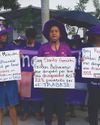Despite what the mainstream media likes to show, antifa isn’t all fighting and doxxing

In the months leading up to the Unite the Right 2 rally in Washington, D.C., my anti-fascist group spent untold hours preparing for the worst. Given that several of us had barely survived the neo-Nazi event’s first incarnation in Charlottesville, VA, the year prior, we expected to have to deal with violence from the rally attendees and from the police protecting them, and we planned accordingly by investing time in self-defence and offensive training, gathering medical supplies to assemble personal medic kits, getting protective clothing, planning our day-of communications strategies, researching the groups we expected to attend, and scouting the area of downtown D.C. in which we expected the fascists to march and then rally.
When, after all that, the most action we saw was less than two dozen fascists standing dejectedly in a park, then being coddled and gently led to safety by thousands of police, we were relieved – but glad that we’d been over-prepared. After having seen Heather Heyer draw her last breath, I never want to repeat that experience with another comrade. The Unite the Right 2 rally itself was a dismal failure, and should have been hailed as a massive win for anti-fascists, except the media spent all of its energy working to undermine our efforts and cast us in the most negative light possible. After a few photographers barged into the Black Bloc and tussled with several people therein, the media launched into its predictable “violent antifa” narrative, with no mention of the way our years of careful and strategic organizing have contributed to the downfall of the alt-right. Come on.
Diese Geschichte stammt aus der January/February 2019-Ausgabe von Briarpatch.
Starten Sie Ihre 7-tägige kostenlose Testversion von Magzter GOLD, um auf Tausende kuratierte Premium-Storys sowie über 8.000 Zeitschriften und Zeitungen zuzugreifen.
Bereits Abonnent ? Anmelden
Diese Geschichte stammt aus der January/February 2019-Ausgabe von Briarpatch.
Starten Sie Ihre 7-tägige kostenlose Testversion von Magzter GOLD, um auf Tausende kuratierte Premium-Storys sowie über 8.000 Zeitschriften und Zeitungen zuzugreifen.
Bereits Abonnent? Anmelden

PLATFORMS FOR PEOPLE, NOT PROFIT
Digital platforms boast that they’ve “democratized” cultural production. But what would truly democratic platforms look like in Canada?

ORGANIZING THROUGH LOSS IN THE HEART OF OIL COUNTRY
The story of climate justice organizing in Alberta, at the heart of the tarsands, is the story of a group of young activists learning what it means to lose, and keep on fighting

GROWING THE LABOUR MOVEMENT
How unions are using community gardens to engage members, nourish communities, and help strikers weather the picket line

A NEW ERA FOR OLD CROW
In the Yukon’s northernmost community, the Vuntut Gwitchin First Nation is reckoning with how to preserve their land and culture, amid a warming climate and an influx of tourists

“At Least Hookers Get Wages”
The risky business of sex work in the gig economy

The Literal – And Literary – Futures We Build
Briarpatch editor Saima Desai talks to two judges of our Writing in the Margins contest about Idle No More and MMIWG, ethical kinship, writing queer sex, and their forthcoming work.

The Cost Of A T-Shirt
In Honduras, women maquila workers are fighting back against the multinational garment companies that they say are endangering their health and safety.

Milking Prison Labour
Canada’s prison farms are being reopened. But when prisoners will be paid pennies a day, and the fruits of their labour will likely be exported for profit, there’s little to celebrate.

Bringing Back The Beat
In mainstream media, labour journalism has been replaced by financial reporting and business sections. But journalism students are raising the labour beat from the grave.

There's No Journalism On A Dead Planet
Corporate media owners are killing local newspapers – which is making it impossible for everyday people to understand the on-the-ground impacts of the climate crisis